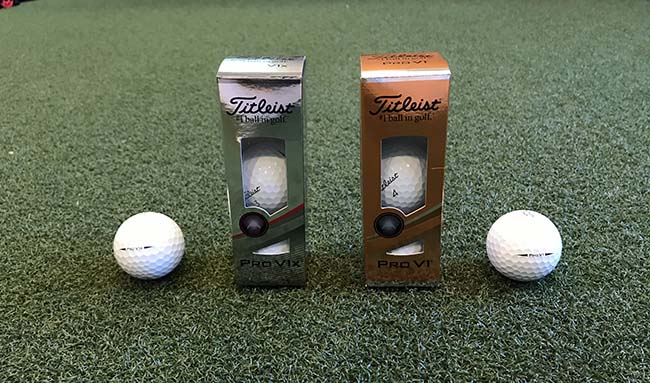
Have you ever wondered what the actual difference between a Titleist Pro V1 vs. Pro V1x is? Titleist's flagship product has dominated the golf ball industry for over a decade now, but many golfers don't know what separates these two.
To be completely honest, I'm not exactly sure how a Pro V1 and Pro V1x perform all that different either. So I decided to test both balls out on my launch monitor to see if there were any noticeable changes in ball flights on several key parameters. In this article, I will share those results along with what Titleist is saying about each ball (and what kind of golfer should use them).
What Titleist Says
Every OEM has their marketing teams craft very detailed documentation about their products. Much of it is fluff, but some are very useful.
According to Titleist's website, here is the difference between the Pro V1 and Pro V1x:
- The Pro V1 has a softer feel, less iron spin, and a more penetrating ball flight.
- Comparatively, the Pro V1x should launch higher, feel a little less soft, and offer more iron spin.
You can view this video they released:
Both balls have a urethane cover, which is now standard for many premium golf balls in the industry. It allows them both to be durable, spins plenty around the greens, but still offer more distance on your tee shots. The Pro V1 is a three-piece ball with 352 dimples, while the Pro V1x has 328 dimples and a four-piece design.
Long story short, there are differences between the Pro V1 and Pro V1x design - but how much does that equate to on the golf course? And which ball should you play?
I decided to put that to the test to shed a little more light for all of you.
Pro V1 vs. Pro V1x Launch Monitor Test

I took each ball and hit full shots with my sand wedge, 7-iron, and driver. I'm looking for differences in overall spin, total distance, peak height, and several other parameters.
Here are the results from my full Sand Wedge swings:
You can see that the Pro V1x is launching higher and with more spin, which holds up to their claims. It's not an enormous gap, but there is a difference.
Now let's take a look at my 7-iron swings:
There is virtually no difference in any of the key launch characteristics here.
Lastly, here is my driver swing data:
Similar to my 7-iron swings, almost no significant changes in ball flight between the Pro V1 and Pro V1x.
Further Analysis
Based on what I saw between the balls, I would not say there was an "earth-shattering" difference. There was definitely more spin with my wedge using the Pro V1x, which does lead to a higher ball flight. That is something that needs to be taken into account.
Additionally, I did not notice any variance in feel when I hit both balls, but that can be subjective.
Now you can take my results with a grain of salt because I am just one golfer. I always encourage players to test the differences in balls themselves to see if there are any significant alterations in ball flight between models.
That being said, I have tested a number of premium golf balls on this site, and I can tell you that they all perform very well. They spin plenty around the greens, provide a soft feel, and still can provide exceptional distance off the tee by lowering spin with your driver. For professional golfers that have paychecks on the line, getting the right ball dialed in is crucial. But for recreational golfers, I do not think you are going to notice anything significant on the golf course.
Overall, I would say that golfers who are looking for more spin on their wedge shots should favor the Pro V1x. On your longer shots, I'm not sure there will be too much of a change between the two.
If you are interested in reading some more ball testing I have done on this site you can check out these articles:
Snell Golf My Tour Ball Review
We care about the protection of your data Read our Privacy Policy